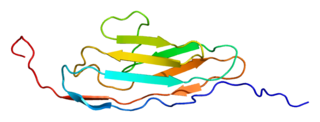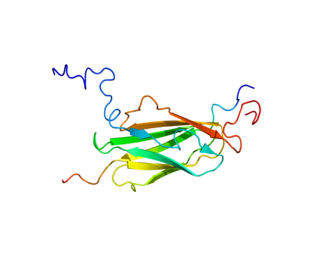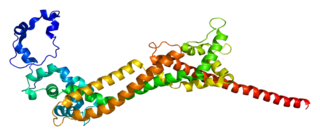
Palladin is a protein that in humans is encoded by the PALLD gene. Palladin is a component of actin-containing microfilaments that control cell shape, adhesion, and contraction.

Chloride intracellular channel 4, also known as CLIC4,p644H1,HuH1, is a eukaryotic gene.

F-actin-capping protein subunit alpha-1 is a protein that in humans is encoded by the CAPZA1 gene.

Wiskott–Aldrich syndrome protein family member 3 is a protein that in humans is encoded by the WASF3 gene.

Cdc42 effector protein 3 is a protein that in humans is encoded by the CDC42EP3 gene.

Beta-parvin is a protein that in humans is encoded by the PARVB gene.

Vinexin is a protein that in humans is encoded by the SORBS3 gene.

Cdc42 effector protein 1 is a protein that in humans is encoded by the CDC42EP1 gene.

Cytoplasmic FMR1-interacting protein 1 is a protein that in humans is encoded by the CYFIP1 gene.

Filamin-binding LIM protein 1 is a protein that in humans is encoded by the FBLIM1 gene.

Myosin light chain 3, skeletal muscle isoform is a protein that in humans is encoded by the MYL1 gene.

Protocadherin-8 is a protein that in humans is encoded by the PCDH8 gene.

Actin-related protein 2/3 complex subunit 1A is a protein that in humans is encoded by the ARPC1A gene.

Dishevelled-associated activator of morphogenesis 1 is a protein that in humans is encoded by the DAAM1 gene. Evidence of alternative splicing has been observed for this gene but the full-length nature of these variants has not been determined.

Endothelial cell-selective adhesion molecule is a protein that in humans is encoded by the ESAM gene.

Probable ribosome biogenesis protein RLP24 is a protein that in humans is encoded by the RSL24D1 gene.

Beta-centractin is a protein that in humans is encoded by the ACTR1B gene.

Girdin is a protein that in humans is encoded by the CCDC88A gene. Although its cellular function are not fully elucidated, it has been associated with glioma.

Rhophilin-1 is a protein that in humans is encoded by the RHPN1 gene.

Amyloid beta A4 precursor protein-binding family B member 1-interacting protein (APBB1IP), also known as APBB1-interacting protein 1 or Rap1-GTP-interacting adapter molecule (RIAM) is a protein that in humans is encoded by the APBB1IP gene.


















